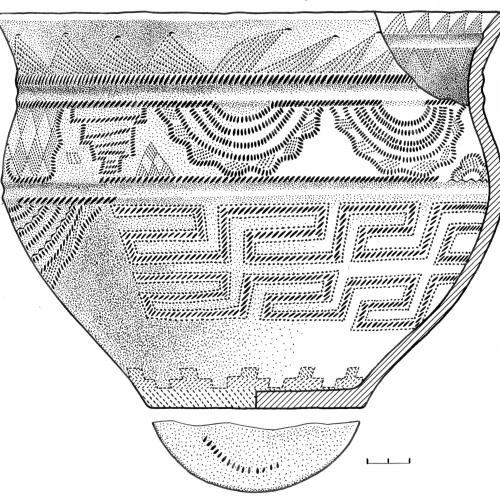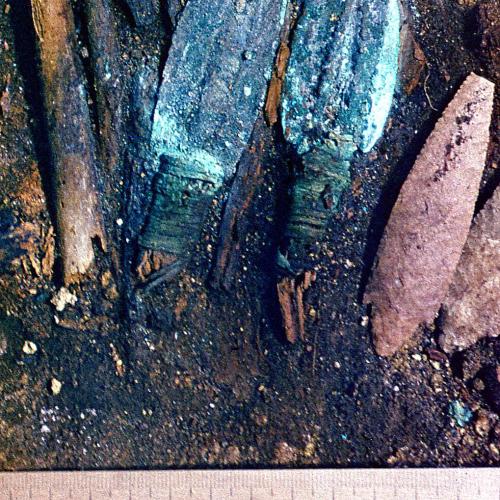Могильник небольшой и функционировал непродолжительное время, возможно, являясь местом захоронения одной семьи.
До начала раскопок могильник представлял собой небольшое, округлое в плане возвышение диаметром 10 – 12 м и высотой до 0,2 м. В ходе исследований установлено, что искусственно возведенной курганной насыпи не было.
В центре могильника располагалось ритуальное сооружение – квадратный в плане домик из деревянных плах, в центре которого в углублении пола был вкопан ритуальный столб. Могильные ямы располагались параллельно сторонам ритуальной площадки и домика, умершие укладывались головой или лицом к ритуальному сооружению. Детские погребения могильника совершались в небольших грунтовых ямах глубиной до 50 см от уровня древней поверхности.
Всего на площадке исследовано девять могил, из которых три – детские. Часть могил оказалась ограблена.
Встречаются погребальные камеры двух конструкций. Первый вариант –деревянные ящики с поперечным перекрытием из сосновых плах или расколотых пополам бревен, которое опирается на боковые стенки камер. Другие представляют собой врытые в дно два или четыре столба. На столбы укладывались лаги, перекрытые двойным слоем плах или бревен.
В нескольких могилах сохранились следы костра на перекрытии камеры и туши или отдельные части жертвенных животных (конь или корова).
Вместе с погребенными укладывали различный инвентарь – керамическую посуду, бронзовые ножи, тесла, шилья, каменный пест. В мужских погребениях встречены кремневые и бронзовые наконечники стрел.
The Small Flat Burial Complex (S-2)
This burial complex, located 370 m northwest of BSK, was excavated in 1974 as part of the Ural Archaeological Expedition (Ural State University) directed by V.F. Gening. The excavation was supervised by N.B. Vinogradov. Before the excavations, this was a rather small (10-12 m in diameter) round earthen mound about 0.2 m tall. Later, it was established that there was no artificial kurgan mound on top of the burials.
9 graves – It total, the burial complex contained nine graves, three of which contained children
1 ritual structure – At the center of the complex was a ritual structure – a square “house” made out of split logs. At the center of the “house”, in a depression, a ritual post was placed in the ground.
Artifacts
The deceased were accompanied by rich (by Bronze Age standards) grave goods: ceramic vessels, bronze knives, adzes, awls, weapons. The most distinguished male and female burials were found in Chamber 7. The entrance into the chamber was in its northern side. Male accessories included bronze and lithic arrowheads, remnants of a bow, a bronze spearhead, a stone mace head, and an axe. Female accessories included a composite silver breastplate, a finger ring, a knife, and an awl. One of unique Sintashta vessel types was found here. Upon closing up the chamber, animal offerings were placed on its roof: two cattle heads, one horse head; while a sheep head, along with horse, cattle and sheep limbs were placed before the entrance. A fire was then burnt on top of the chamber. Traces of ritual fires along with traces of backfill were observed on top of this and a few other burial chambers.
Burial complex architecture
The rather large (up to 2.9 x 2.1 x 3.3 m) graves were situated parallel to the sides of the ritual plaza and the “house”.
Children were buried in shallow graves, up to 50 cm deep. Some of the graves were robbed. The graves of the adults contained wooden chambers made out of split logs, which were laid horizontally. The flat roofs of the chambers were made out of one to two rows of logs. In cases of double-layered roofs, there were additional posts added either in the corners or next to the walls of the chambers. Some of the wooden chambers were partially or fully inserted into hollow spaces dug out in the walls of the graves. One of the burials (No. 10) is of a catacomb type. The deceased lay with their heads or faces towards the ritual structure.






